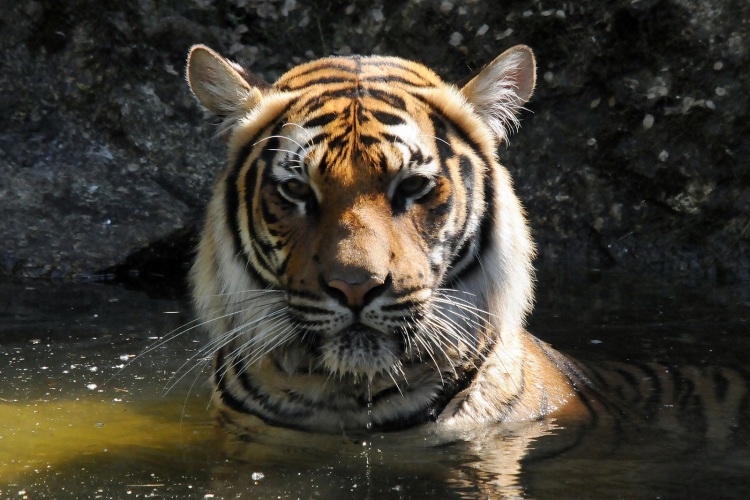
The Indochinese tiger (Panthera tigris corbetti) is considered to be functionally extinct in Cambodia. These cats, which are thought to be the population from which all other tiger subspecies originated, were plentiful in Cambodia as recently as 1999 (Lynam & Nowell, 2011). But no Indochinese tigers have been seen in Cambodia since 2007. The Cambodian government and the World Wide Fund for Nature (WWF) want to change that. However, leading tiger experts fear that their plan is doomed to fail.
The Cambodian government and the WWF are planning to reintroduce tigers to Srepok Wildlife Sanctuary in Mondulkiri Province. Dr. Thomas Gray, the Science Director for the Wildlife Alliance, claims that this area contains excellent tiger habitat. Unfortunately, there are significant roadblocks to tiger recovery in Cambodia.
Tigers became functionally extinct in Cambodia largely due to poaching and habitat loss. These threats have not gone away. Poaching remains rampant in Cambodia, deforestation continues at a rapid pace, and widespread poverty and corruption compound these problems. Leading tiger experts maintain that these factors would need to be addressed before tigers have any hope of recovery in Cambodia.
In addition, the Cambodian government has been clear that part of the reason they want to reintroduce tigers is to encourage tiger-related tourism. This is not necessarily a bad thing. If done correctly, ecotourism can represent a low impact source of revenue for Mondulkiri Province. But it will not be easy.
Establishing quality eco-tourism operations will be a long process. It might take decades to restore tigers in the Srepok Wildlife Sanctuary – and to get those tigers to feel comfortable around safari vehicles. As such, the Cambodian government will likely not see immediate returns on their investment.
Despite these challenges, there is hope for tigers in Cambodia – just not right now. Dr. John Goodrich of Panthera says that the Cambodian government first needs to bring the threats to tigers under control; they need to develop the conditions that would be conducive to tiger recovery before reintroducing the cats. If they can do this, then in the future there may well be tigers in Cambodia again.
The source material for this post came from an article first published by Mongabay. Click here to read the original story.
“…they need to develop the conditions that would be conducive to tiger recovery before reintroducing the cats…
They NEED to, but from what I’m reading it sounds like they won’t (?)
As soon as I saw that it was about tourism/money, what you’d written before made sense. Thing is, they will never be able to develop perfect conditions for the tiger because poachers will always exist. They will bring the tigers in anyway and the animals will suffer.
LikeLiked by 1 person
At this point it’s unclear how the Cambodian government will handle this situation. I’m guessing they’re going to move forward with tiger reintroduction, but it remains to be seen how they’ll do it. Hopefully they’ll take the time to reduce the threats to tigers before bringing the cats back. Issues like poaching will probably always be present, but it’s at least theoretically possible to reduce their severity. I’m hoping that since so many tiger experts are urging caution, that the Cambodian government will listen. They won’t make any money off tourism if all the tigers they bring in are killed.
LikeLiked by 1 person
“They won’t make any money off tourism if all the tigers they bring in are killed.”
Yes, good point.
LikeLiked by 1 person
“They won’t make any money off tourism if all the tigers they bring in are killed.”
What if you reverse the cause & effect, do we think that a failure to make money on tiger tourism will lead them to kill their tigers?
Needless to say I’m a bit dubious about the whole prospect and pretty wary about the cost in terms of conservation dollars and in terms of wild tigers captured, relocated and sent to a ( potentially ) more dangerous place. Even then there are serious questions about where these tigers would be coming from.
LikeLiked by 1 person
Hmm, it’s hard for me to say if a failure to make money from tourism will lead Cambodian officials to kill their tigers. If money is their dominant motive, then it’s possible. After all, dead tigers are quite valuable on certain markets. But “possible” just means a greater than zero chance, and I don’t know enough about Cambodia to say if such an event is “likely.”
There’s a lot to be dubious of with this plan. It’s not like many countries have excesses of tigers to give away, and there certainly isn’t an excess of conservation funding available. At this point, reintroducing tigers in Cambodia seems like it would be more trouble than its worth. Maybe the situation will de different in a decade or two.
LikeLike
I should also add that the original article goes into way more detail than I did. Here’s the link:
https://news.mongabay.com/2017/11/is-cambodias-plan-to-reintroduce-tigers-doomed-to-fail/?n3wsletter&utm_source=Mongabay+Newsletter&utm_campaign=1868686cdf-newsletter_2017_11_02&utm_medium=email&utm_term=0_940652e1f4-1868686cdf-67233543
LikeLiked by 1 person
Thank you.
LikeLiked by 1 person
Thank YOU for commenting!
LikeLiked by 1 person
I was pretty much thinking the same thing. Before introduction, they really need to fix the problem that caused these tigers’ demise. Thanks for the additional link. Recently in San Diego, they confiscated a smuggled cub in the trunk of a car crossing the border. It amazes me how thoughtless these people that do these things can be. I believe the cub was taken to the SD Zoo or the Wild Animal Park as it was minus a protective mother. Sad.
LikeLiked by 1 person
That’s awful to hear about the tiger cub! The pet trade is definitely a problem.
Yea, the Cambodian government needs to get a handle on poaching, deforestation, and corruption before bringing tigers back. Otherwise the tigers will just be killed.
LikeLiked by 1 person
Reblogged this on "OUR WORLD".
LikeLiked by 1 person